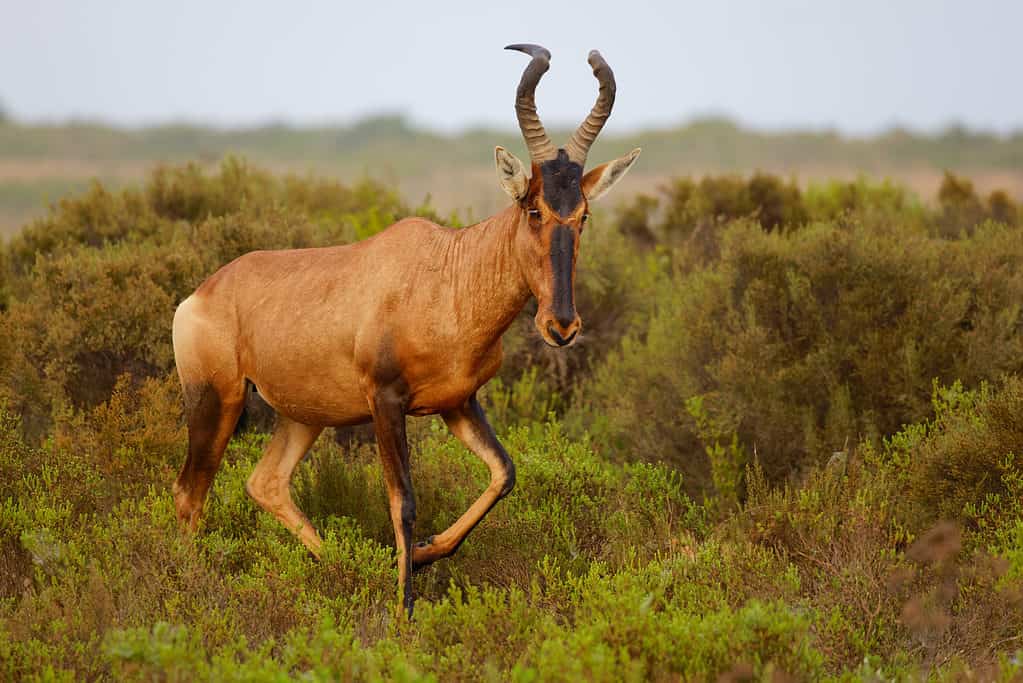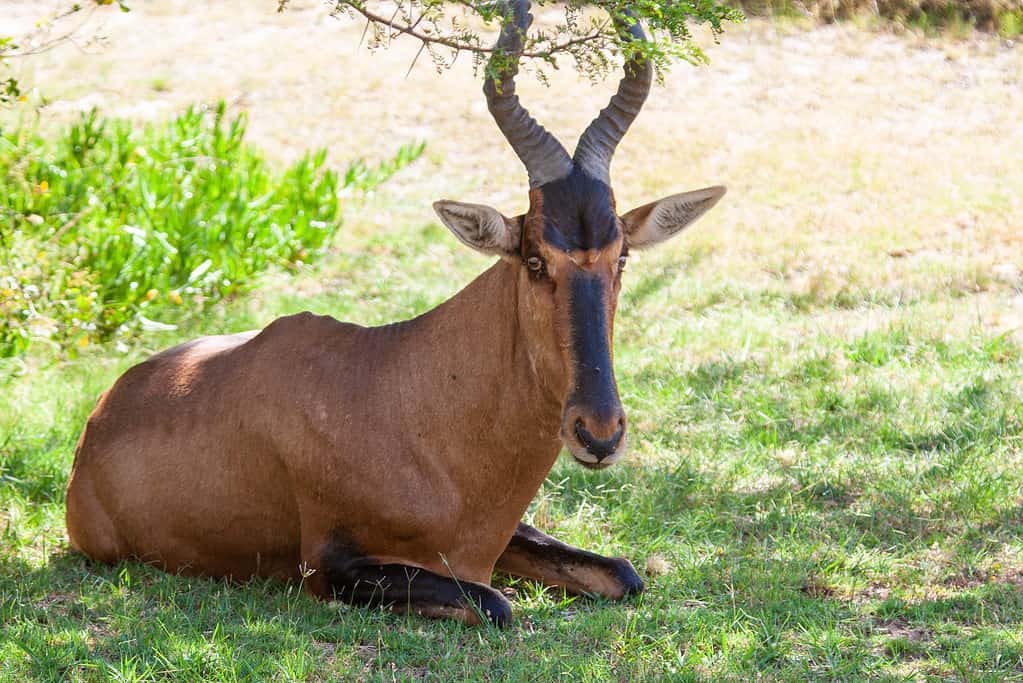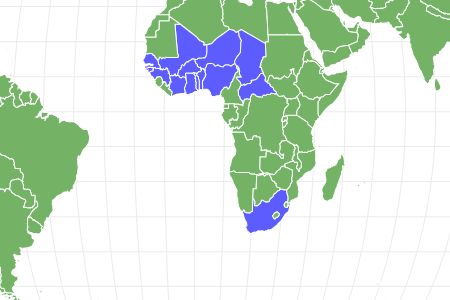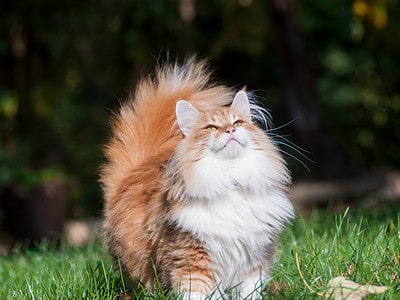Hartebeest
Alcelaphus buselaphus
Unlike other animals that move towards the water source, hartebeests move to more arid locations after rainfall.
Advertisement
Hartebeest Scientific Classification
- Kingdom
- Animalia
- Phylum
- Chordata
- Class
- Mammalia
- Order
- Artiodactyla
- Family
- Bovidae
- Genus
- Alcelaphus
- Scientific Name
- Alcelaphus buselaphus
Read our Complete Guide to Classification of Animals.
Hartebeest Conservation Status
Hartebeest Facts
- Name Of Young
- calf
- Group Behavior
- Herd
- Fun Fact
- Unlike other animals that move towards the water source, hartebeests move to more arid locations after rainfall.
- Estimated Population Size
- 362,000
- Biggest Threat
- Human activities
- Most Distinctive Feature
- Long, V-Shaped horns
- Distinctive Feature
- They have a small but conspicuous hump on their back
- Other Name(s)
- Kongoni, kaama
- Gestation Period
- 240 days
- Habitat
- Grasslands and savanna
- Predators
- Lions, leopards, hyenas, cheetahs, jackals
- Diet
- Herbivore
- Average Litter Size
- 1
- Lifestyle
- Nocturnal
- Diurnal
- Favorite Food
- Grass
- Type
- Antelope
- Common Name
- Hartebeest
- Special Features
- Hartebeest's have an elongated forehead with oddly shaped horns
- Location
- Africa
Hartebeest Physical Characteristics
- Color
- Brown
- Tan
- Dark Brown
- Skin Type
- Leather
- Top Speed
- 43 mph
- Lifespan
- 11-20 years
- Weight
- 264–485 pounds
- Height
- 5–8 feet
- Length
- 3–5 feet
- Age of Sexual Maturity
- 1–2 years
- Age of Weaning
- 4-8 months
- Venomous
- No
- Aggression
- Low
View all of the Hartebeest images!
Hartebeest is a large antelope species native to the African continent. It lives in open grasslands, sparsely wooded areas, and savannas. Although once widespread across Africa, the antelope’s population has been on a decline due to habitat destruction and other human activities.
5 Hartebeest Facts
- During the mating season, males become violent and territorial, and they use feces to demarcate their area.
- Pregnancies typically last eight months and result in a single baby (calf).
- Hartebeests become mature between ages one to four.
- Unlike other animals that move towards water, hartebeests move to more arid locations after rainfall.
- The hartebeest is active during the day (diurnal)
- They have an 11 to 20 years natural life expectancy and up to a 19-year domesticated life expectancy.
Hartebeest — Scientific Name
The Hartebeest’s scientific name is Alcelaphus buselaphus. A member of the Bovidae family, this giant African antelope is also called kaama or kongoni. The Bovidae family consists of cloven-hoofed ruminant mammals,, which includes bison, antelopes, and caprines.
The common name “hartebeest” is of Dutch origin. The word literally translates as “deer beast.” The early Dutch settlers probably mistook the antelope for a deer. Kongoni, a popular nickname for this antelope, is used for one of its subspecies, the Coke’s hartebeest, and is of Swahili origin.
The harbeest has seven different subspecies which include:
- Western hartebeest — Alcelaphus buselaphus major
- Lichtenstein’s hartebeest — Alcephalus buselaphus lichtensteinii
- Red hartebeest — Alcephalus buselaphus caama
- Large Lelwel hartebeest — Alcephalus buselaphus lelwel
- Coke’s hartebeest — Alcephalus buselaphus cokei
- Swayne’s hartebeest — Alcephalus buselaphus swaynei
- Tora hartebeest — Alcelaphus buselaphus tora
Hartebeest — Appearance and Behavior
Alcelaphus buselaphus is a huge antelope that typically measures about three to five feet wide at the shoulder and five to eight feet in body length. The unusually enlarged foreheads and horns of this animal further exaggerate its size. Their weight ranges from 220 to 440 pounds.
The hartebeest has a tuft of black fur towards the end of its 16 to 24-inch tail. One of the most distinctive traits is its long legs (which are commonly marked with black). It also has a short neck and pointy ears.
All members of this species have horns. However, females typically sport thinner horns compared to males. The length of its horn can range from 18 to 28 inches, with a maximum of 29.5 inches. In addition to the long face and broad chest, the hartebeest stands apart from other antelopes thanks to its sloping back. They also have a small but conspicuous hump just over the shoulders.
Alcelaphus buselaphus is a herd animal. They form groups of about 300 but sometimes as high as 10,000 individuals. The species has a unique social structure that is remarkably different from that of other antelopes. Adult females don’t form long-term bonds with other members of their species. Instead, they form separate aggregations with as many as four generations of their own offspring. Females are defensive of their young. However, they are generally easygoing antelopes.

The hartebeest (
Alcelaphus buselaphus) is a huge antelope weighing 220 to 440 pounds with an enlarged forehead and thick horns.
©iStock.com/CWP
Evolution and History
The hartebeest is the only known member of the Alcelaphus genus, which evolved about 4.4 million years ago. Other related antelopes that may have evolved around the same time include the Megalotragus, Damalops, Rabaticeras, and Numidocapra. Based on studies that examined the geographic distribution of the species, experts think they may have originated from East Africa. Within a few years, the species spread so quickly that it displaced other antelope species that were dominant on the African continent before them.
As the hartebeest evolved, they split into two distinct lineages. By 0.5 million years ago, the genus was split into the northern and southern lineages. The northern lineage further evolved into western and eastern varieties roughly 400 thousand years ago. Experts believe this divergence happened due to the expansion of the central African rainforest belt and contraction of the savanna habitats, which happened at the time due to climate change.
The current Coke, Swayne, Lelwel, and tora hartebeests evolved from the eastern lineage, while the bubal and western varieties evolved from the western lineage. The southern lineage, on the other hand, evolved into the red and Lichtenstein’s hartebeest. Both subspecies evolved about 0.2 million years ago. The oldest fossil ever found dates back to 0.7 million years ago.
Hartebeest — Habitat
Alcelaphus buselaphus once roamed from the Middle East to North Africa all the way south to the tip of Africa. It lives in the savannas and grasslands across various countries on the continent. In the past, they spanned much of the African continent but can now be found primarily in sub-Saharan Africa. Habitat destruction due to human activities has led to the decline of this species across their former native homes.
Wooded grasslands and savannas are the typical habitats for these antelopes. They tend to move away from areas with abundant rain to more arid areas. Some groups of hartebeest have been reported in high altitude areas as high as 13,000 feet like Mt. Kenya.

Hartebeest prefer wooded grasslands and savannas as their habitat.
©iStock.com/Wayne Marinovich
Hartebeest — Predators and Threats
The hartebeest is a popular game animal that has been hunted by humans for several thousand years. Experts believe ancient Egyptians hunted and probably domesticated this antelope. Today, the grazing herbivore is still hunted for meat and also killed by trophy hunters in locations where their population is not protected.
What Eats Hartebeests?
The hartebeest faces threats from human settlement, hunting, and habitat destruction. They are popular game animals due to their highly regarded meat. The major predators of this antelope are cheetahs, jackals, hyenas, and leopards.
What Does the Hartebeest Eat?
These large antelopes feed almost entirely on grass, are not very selective, and are quite tolerant of poor-quality food. They have suffered from the expansion of cattle raising, forcing them to compete for the same food.
Reproduction, Babies, and Lifespan
Hartebeest mate year-round. However, food availability likely affects the timing of the peak mating season. The antelope reaches sexual maturity typically between the ages of one and two. The reproductive process might vary depending on geographic location and species. Each male defends his own territory where mating occurs, and these territories are typically open regions.
After a vicious battle for dominance among the males, the victor sniffs the female’s genitalia and, if she is in estrus, follows her. On occasion, a male will actively try to block the path of a female in estrus, holding out her tail in a subtle way to show her receptivity. Eventually, she might just sit motionlessly and let the male mount her. The act of copulation itself lasts only a few seconds, but it can happen multiple times in a single minute. Females in huge herds often have sexual relationships with multiple males.
The gestation period lasts for around nine months, and the birth of a single calf averages 20 pounds. Unlike the wildebeest, which typically give birth in large herds on open plains, most antelope give birth in thickets during the dry season. Calves are able to get around on their own soon after birth, but they prefer to sleep in the open near their moms.
The calf is weaned at four months of age. Young males remain with their moms for two and a half years, which is longer than their close relatives. Male adolescents have a high death rate because territorial adult males deny them good food, and they often fall prey to predators.

A male hartebeest will defend his own territory where mating occurs.
©Sander Steven Lang/Shutterstock.com
Population
About 362,000 hartebeests currently live in the wild, per the IUCN Red List. The populations vary across the different subspecies.
- Red hartebeest — 130,000
- Swayne’s hartebeest — 800
- Western hartebeest — 36,000
- Lelwel hartebeest — 70,000.
- Lichtenstein’s hartebeest — 82,000
- Coke’s hartebeest — 42,000
The conservation status also varies from one subspecies to the other. For instance, while the population of the red variety is currently on the rise, the IUCN declared the bubal hartebeest extinct in 1994. The Tora hartebeest, on the other hand is critically endangered. The hartebeest is now extinct across countries where they were previously abundant such as Algeria, Libya, Morocco, Lesotho, and Tunisia.
Related Animals
View all 104 animals that start with HHartebeest FAQs (Frequently Asked Questions)
Are hartebeests carnivores, herbivores, or omnivores?
The hartebeests are herbivores, and their diet consists mostly of grasses. They can survive on watermelons, roots, and tubers in arid regions.
Are hartebeests fast?
Yes, hartebeests are fast. In fact, they can run up to 43 miles per hour, making them one of the quickest antelopes, and they can run for long distances.
Do female hartebeests have horns?
Yes. Horns are present in both males and females of every subspecies. However, the horns of female hartebeests are thinner than those of males.
How do hartebeests protect themselves from predators?
Hartebeests use their long horns to ward off predators. Males also use it to fight other males for territorial space.
Thank you for reading! Have some feedback for us? Contact the AZ Animals editorial team.
Sources
- Wikipedia, Available here: https://en.wikipedia.org/wiki/Hartebeest
- African Wildlife Foundation, Available here: https://www.awf.org/wildlife-conservation/hartebeest
- South Africa Venues, Available here: https://www.sa-venues.com/wildlife/wildlife_hartebees.php
- Animal Spot, Available here: https://www.animalspot.net/hartebeest.html
- IUCN Redlist, Available here: https://www.iucnredlist.org/species/811/143160967


















